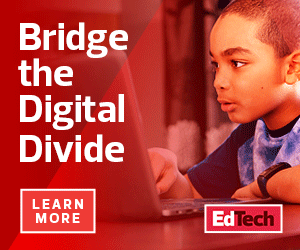EDTECH: What about their access to devices? What sorts of challenges are you seeing there?
MARWELL: There are estimates that roughly 25 percent of students don’t have a device they can use for learning at home, and the numbers may be higher when you think about each student needing to have their own device. So, in other words, they can’t share it with their siblings, who are trying to get into online school at the same time, or their parents, who may need it for work, if you really want them to participate in learning.
The good news is that over the last few years, school districts across the country have bought somewhere around 30 to 45 million devices to be used in school, so it’s not like there are no devices available. There are some communities that don’t have them in their schools at all, for sure. But there’s also the challenge of school districts sending devices home for the first time. That involves setting up policies, figuring out how to maintain the devices and deciding who gets one. Those things have been a real struggle for many schools.
EDTECH: What can school districts do to make online remote learning possible for students?
MARWELL: One solution people are looking into, particularly for students in vulnerable populations such as those facing homelessness, are mobile hotspots. Many school districts have purchased them from wireless carriers and gave them out to students as part of their strategies for getting them online.
But when it comes to remote learning as a whole, I think we’re now moving into phase two, where school leaders are thinking about how they’ve had varying degrees of success with it, but the reality is they’re not ready. Everyone’s asking themselves how to get ready for school in the fall because almost every reopening scenario they’re looking at will need to be supported by remote learning. It may be that schools can’t open in the fall or that they’ll be using staggered schedules where kids are in the school two days a week and learning from home three days a week.
There definitely is no one-size-fits-all solution, so I would encourage them to check out Digital Bridge K–12. We have a lot of primers about the different solutions available to you, whether it’s wireline solutions, home cable modems or broadband or mobile hotspots.
Watch Michael Flood, senior vice president of strategy at Kajeet, discuss how to improve connectivity for K–12 students.
EDTECH: What exactly is Digital Bridge K–12, and how can districts use it to their advantage?
MARWELL: Digital Bridge K–12 is an effort to really close that remote learning gap as quickly as possible. What we’re doing is we’re building a playbook, a set of tools to help districts do three things: figure out which of their students don’t have internet access or a dedicated device, get those kids connected to the internet by helping them work with service providers and assist schools in device distribution and management.
It turns out that school districts are really struggling with figuring out which of their students can participate in remote learning. Most schools tried to answer that by sending out a survey, but what we’ve found is they don’t work, especially if you’re sending out digital surveys to people who don’t have internet. We’ve been working with a number of school districts on some alternatives, such as using information they have about who is attending Zoom classes or logging into Google Classroom and then taking a phone banking approach — calling or sending out an SMS text — to reach students who weren’t able to participate.
We’re also helping districts find service providers in the area that can serve their students, what the best deals are and how families can sign up. Plus, we’re providing budget calculators so districts can estimate costs for solutions such as wired or wireless connections. Lastly, we’re helping schools figure out how to send devices home, like setting up a lending program where students who need them can safely and effectively use all of the devices you’ve purchased.
Adjacent to those three things is doing work on a federal level — trying to get government funding for home connectivity and devices in the next stimulus bill. We’ve also been doing a lot of work at the state level to help states understand what role they can play in helping close this remote learning gap with their school districts. The one piece of good news is that schools are getting a little over $13 billion of funding from the CARES Act, and connectivity solutions are eligible under that. But a lot of that money is probably going to be used to plug holes in a school district’s budget, so that’s why we think it’s so important for the federal government to step in and provide resources, at least for the coming school year.
EDTECH: What are other key considerations school leaders should keep in mind as they’re working on solving this issue?
MARWELL: One of the things that we’ve observed is that even in situations where schools are willing to pay for internet access or devices, they’re running into adoption issues where families just don’t take them up on their offer. One way you can overcome that is by partnering with teachers who have relationships with families, as well as trusted community-based organizations to get the word out and make sure families take advantage of those offers.
The second thing I would say is that you’ll need to make sure internet access at school is also up to snuff. If educators are teaching some kids in the classroom and some at home, those at home will need to be able to watch and listen to what their teacher is doing. It’s important to look at your internet access and do some upgrades to make sure that it doesn’t become a bottleneck and that teachers can have live video broadcasting happening in their classroom when they need it.
EDTECH: What do you hope school leaders learned from their experience with remote learning last spring?
MARWELL: I hope that the biggest lesson learned is that we weren’t ready and that we need to be. There are school districts that were pretty well prepared. The ones that were in the best positions were the ones that made a concerted effort to go one-to-one, for example. That probably isn’t an option anymore. It just needs to become part of every school strategy for teaching and learning. I hope more schools will see that and that school boards and communities will support that.












